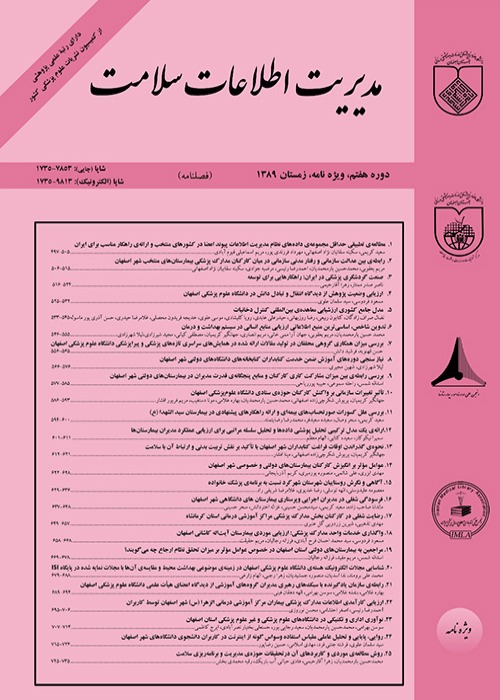Classification and Clustering Algorithm Application for Prediction of Tablet Numbers: Case Study Diabetes Disease
Author(s):
Abstract:
Introduction
By diabetes outbreak in these days، prediction of tablet daily usage like Glibenclamid and Metformin helps doctors to recognize number of tablets، and prevents from drug abuse side effects. Also، it should be considered that the need of diabeticto drug is critical. So، in this paper we have used data mining techniques to predict the number of daily usage of tablets for diabetes. At the end، in evaluation process the algorithm that causes better results will be chosen. Methods
This study done by descriptive-cross sectional method. It done by Census sampling method and contains all 2783 patients from March 2008 to May 2012. The community research consists of Yazd Diabetes Research Center data dependent to Shaeed Sadoughi University of Medical Sciences Yazd and diabetes center agency confirms the records contents. In data preprocessing step، the records with missing value in some fields have been removed by the experts’ opinion and the number of patients reduced to 740 cases. These results have achieved by referring directly to the Yazd Diabetes Research Center and data gathering method validity confirmed by supervisor and specialists. Also reliability value have compared to each other for two used algorithms by measurement of test dataset accuracy. In this study Clementine 12. 0 has been used for data analysis and data mining algorithms application. Two different algorithms namely CHAID and C5. 0 have been used on data and then the generated models accuracy has been achieved. At the end، to confirm the accuracy، we have used clustering method. Results
The obtained values for generated models accuracy by C5. 0 and CHAID algorithm''s execution on dataset was 45/52 and 28/38 respectively. The high accuracy of C5. 0 model shows the better performance of this algorithm for number of tablet usage prediction. In other hand، the low accuracy of C5. 0 model shows some values have not classified directly in own location، due to the comparison of actual and predicted values for number of tablet usage in model generation shows the reasons of low accuracy of each model. The reason was dependent to predicted values which had low accuracy and confidence. The clustering of obtained results of C5. 0 algorithm executing، put 3، 5، 6 and 7 of tablet usage with 46/83، 36/36، 55/71 and 15 percent of predicted value accuracy، respectively، in one cluster because the cases which have low accuracy or have low samples will be located in the same cluster. Also the clustering of CHAID algorithm executing results put 5 of tablet usage with 20/93 percent of predicted value accuracy in a cluster. Conclusion
This paper was done by Data Mining group''s research of K. N. Toosi University of Technology. Finally it has been completed by team work and resulted into present research. In Diabetes Center، an organized approach to predict number of daily usage tablets and prediction from side effects of false recognition in number of tablets is necessary. In order to prevent dangerous effects of diabetes، it is better to invent novel approaches by the help of expert consultant and use of computerized technologies، internet and analytical softwares.Keywords:
Language:
Persian
Published:
Health Information Management, Volume:10 Issue: 5, 2014
Page:
739
magiran.com/p1226336
دانلود و مطالعه متن این مقاله با یکی از روشهای زیر امکان پذیر است:
اشتراک شخصی
با عضویت و پرداخت آنلاین حق اشتراک یکساله به مبلغ 1,390,000ريال میتوانید 70 عنوان مطلب دانلود کنید!
اشتراک سازمانی
به کتابخانه دانشگاه یا محل کار خود پیشنهاد کنید تا اشتراک سازمانی این پایگاه را برای دسترسی نامحدود همه کاربران به متن مطالب تهیه نمایند!
توجه!
- حق عضویت دریافتی صرف حمایت از نشریات عضو و نگهداری، تکمیل و توسعه مگیران میشود.
- پرداخت حق اشتراک و دانلود مقالات اجازه بازنشر آن در سایر رسانههای چاپی و دیجیتال را به کاربر نمیدهد.
In order to view content subscription is required
Personal subscription
Subscribe magiran.com for 70 € euros via PayPal and download 70 articles during a year.
Organization subscription
Please contact us to subscribe your university or library for unlimited access!



